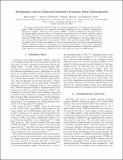Morphology control of epitaxial monolayer transition metal dichalcogenides
View/
Date
01/2020Grant ID
ep/l017008/1
714193
2016-006
URF/R/180026
Metadata
Show full item recordAbstract
To advance fundamental understanding and ultimate application of transition-metal dichalcogenide (TMD) monolayers, it is essential to develop capabilities for the synthesis of high-quality single-layer samples. Molecular beam epitaxy (MBE), a leading technique for the fabrication of the highest-quality epitaxial films of conventional semiconductors has, however, typically yielded only small grain sizes and suboptimal morphologies when applied to the van der Waals growth of monolayer TMDs. Here, we present a systematic study on the influence of adatom mobility, growth rate, and metal:chalcogen flux on the growth of NbSe2, VSe2, and TiSe2 using MBE. Through this, we identify the key drivers and influence of the adatom kinetics that control the epitaxial growth of TMDs, realizing four distinct morphologies of the as-grown compounds. We use this to determine optimized growth conditions for the fabrication of high-quality monolayers, ultimately realizing the largest grain sizes of monolayer TMDs that have been achieved to date via MBE growth.
Citation
Rajan , A , Underwood , K , Mazzola , F & King , P 2020 , ' Morphology control of epitaxial monolayer transition metal dichalcogenides ' , Physical Review Materials , vol. 4 , no. 1 , 014003 . https://doi.org/10.1103/PhysRevMaterials.4.014003
Publication
Physical Review Materials
Status
Peer reviewed
ISSN
2475-9953Type
Journal article
Description
Funding: AFM system (funded via an EPSRC equipment grant: EP/L017008/1) used in this work and experimental support. The Leverhulme Trust (Grant no. RL-2016-006); The Royal Society; the European Research Council (Grant No. ERC-714193-QUESTDO). K.U. acknowledges EPSRC for PhD studentship support through grant no. EP/L015110/1.Collections
Items in the St Andrews Research Repository are protected by copyright, with all rights reserved, unless otherwise indicated.

